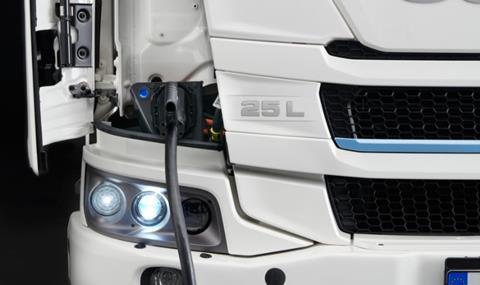
Scania has revealed plans to launch a range of fast-charging electric long-distance HGVs within the next few years as it ramps up its drive towards battery-powered sustainable vehicles.
Speaking as the company unveiled its first series production range of electric trucks, consisting of full electric and a plug-in hybrid, Scania president and chief executive Henrik Henriksson said further launches in other sectors will follow on an annual basis.
“Of particular significance is that in a few years’ time we will also introduce long-distance electric trucks adapted for fast-charging during drivers’ compulsory 45-minute rest periods," he confirmed.
Offered in both L- and P-series rigid guises, Scania’s latest e-trucks are aimed squarely at urban applications. In addition to general cargo and temperature-controlled transport, they can be equipped with a wide range of bodywork, such as hook-lifts, tippers, concrete mixers and refuse collectors.
The company will be talking in detail with potential UK customers this winter, with the first right-hand-drive product arriving in the second quarter of 2021.
Prices are yet to be announced, but Scania said in the mid-term, the total cost of ownership of battery-powered heavy distribution trucks will be comparable with those powered by fossil fuels.
The company expects the hybrid to initially be the most popular of the two models, due to its flexibility.
Scania GB will also be creating a series of regional servicing hubs, strategically located throughout the UK. Additional servicing points will be added in accordance with demand.
Speaking exclusively to motortransport.co.uk, Scania's UK sales director, Vincente Connolly admitted that despite strong interest among UK operators for both the full-electric and hybrid trucks, he anticipates initial slow demand, not helped by the charging infrastructure still being in its infancy.
However, he added that electric vehicles will "increasingly become an attractive option and we will, in the initial stages, develop and deploy hybrid and fully electric trucks in partnership with progressive operators who share our ambition and commitment to sustainability".
“There are a number of operators who are keen to understand the dynamics of operating both full-electric and hybrid vehicles, and we will look for strong partnerships with early adopters to understand their operation and broaden our understanding of vehicles in service,” he said.
“As [the charging infrastructure] matures, so we will see a steady increase of adopters.”
FULL-ELECTRIC TRUCK
Scania’s full-electric, zero-emission L- and P-series trucks are driven by a 230kW motor, which is the equivalent of 310hp (2,200Nm). They are offered with a choice of 165kWh or 300kWh battery packs, depending on the operator’s requirements.
One battery is located in the former engine tunnel, while the remaining four (165kWh) or eight (300kWh) batteries are placed along the chassis rails. Other components, such as battery management units, battery cooling components, electrohydraulic steering system, electric air compressor and inverter, are also mounted along the chassis frame.
Range is dependent on a number of factors, including application, weight and topography, but Scania says in 300kWh format, a distance of up to 250km can be achieved on a single charge. With five batteries, the range is reduced to a maximum of 130km.
The batteries can be charged by 130kW DC using a combined charging system (CCS) connector. It takes less than 55 minutes to charge the five-battery pack and less than than 100 minutes for the nine-battery option. In addition, the batteries are continuously charged on the road through regenerative braking energy.
“Sustainable emission-free transport is set to become a requirement for transport operators,” commented Connolly, at the launch. “Acquiring electric trucks will become not just an investment in the customer’s fleet, but also in its brand and the market in which it operates. Electric trucks will enable the operator to stay ahead of the competition, learn about infrastructural challenges and start adapting for the future.”
PLUG-IN HYBRID TRUCK
Scania’s plug-in hybrid trucks, combine a regular 9-litre combustion engine (280hp – 360hp) with an electric driveline. They utilise a 115kW electric motor, powered by three batteries with a combined capacity of 95kWh DC. The charging time from zero to 80% is approximately 35 minutes, and additionally they are charged on the move via regenerative braking. They can travel up to 60km in full electric mode, allowing the driver to switch from diesel to electric mode when entering an urban environment.
“Incorporating hybrid trucks into hauliers’ fleets is doubtless the simplest way of gaining experience of operating electric vehicles,” said Connolly.
“Acting as a bridge between the different technologies, hybrids enable operators to gradually expand their fleets to include a greater proportion of electric vehicles. As clean air zones become more prevalent, they will also open up opportunities for operators based around cities looking to travel in for work.”
Scania launched its first hybrid truck in 2014.














